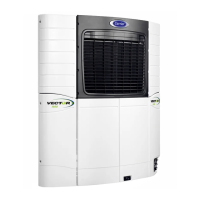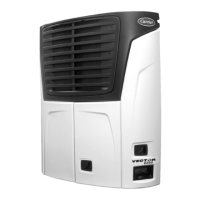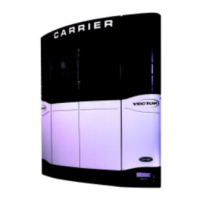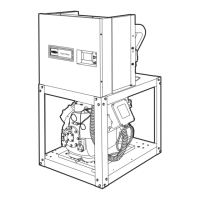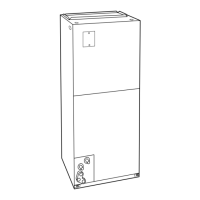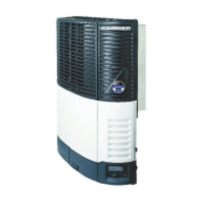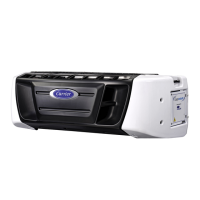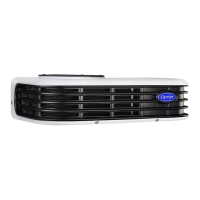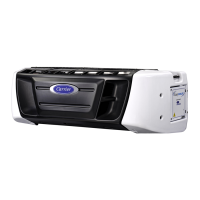62-61753-21
SECTION 4 -
TEMPERATURE CONTROL
NOTES
1. If the unit is in an alarm condition, the microprocessor alarm response may override the operation de-
scribed herein. If an alarm is displayed in the MessageCenter, refer to the specific alarm description in
Section 7 for "Unit Control" descriptions.
2. With the complex control systems in use with the LogiCOLD microprocessor there are many user se-
lected and preprogrammed software overrides which may change the operation of the unit. Refer to
Sections 4.6 & 4.7 for complete descriptions of these features.
4.1 INTRODUCTION
This section describes engine and refrigeration system
operation in relation to temperature control in both
Engine and Standby Operation. For descriptions of
refrigerant system component operation when cooling,
or heating, with flow diagrams, refer to sections 2.14
and 2.15.
4.2 SYSTEM START-UP
Engine or Standby Operation is chosen by positioning
of the STANDBY/ENGINE switch (DES).
With the switch in the STANDBY position the power
supply contactor relay (PSCONR) is energized. Ener-
gizing PSCONR reverses its contacts to allow power
from the power plug while the engine is shut down and
power from the generator is locked out.
With the switch in the ENGINE position the generator
contactor relay (GENCONR) is energized. Energizing
GENCONR reverses its contacts to allow the engine
and generator to operate while power from the power
plug is locked out.
The start/run-off switch (SROS) is then placed in the
START/RUN position to start the unit.
The microprocessor energizes the unloader solenoid
valve (USV). The economizer solenoid valve (ESV)
and liquid injection solenoid valve (LIV) remain de-
energized, allowing the unit to start in the Bypass
Mode.
The compressor suction modulating valve (CSMV) and
evaporator expansion valve (EVXV) will both close
(0% open).
NOTE
The unit will not restart for at least 30 seconds
following a shutdown.
4.2.1 Standby Start-Up
On command to perform a Start-Up the microproces-
sor will determine if there is a need to perform a Bump
Start. Bump Start is performed to clear refrigerant from
the compressor and/or return oil and will be activated
if:
the compressor has been off for more than four
hours or
suction and discharge pressure are within 0.7 bar
(10 psi) or
suction pressure is above discharge pressure
During Bump Start the microprocessor will de-energize
the unloader solenoid valve (USV), economizer sole-
noid valve (ESV) & liquid line solenoid valve (LIV) and
energize the buzzer for five seconds. Then the com-
pressor will operate for one second on followed by
seven seconds off. The on/off sequence will repeat
two additional times.
Following Bump Start the compressor will transition to
steady state operation, and the evaporator fans will
start.
If Bump Start is not required, the buzzer will be ener-
gized for five seconds the compressor will start and
the evaporator fans will start.
The condenser fan may operate or cycle during the
start-up process depending on temperature and pres-
sure conditions.
The compressor will continue to operate for a mini-
mum of three minutes after start-up with the refrigera-
tion system operating in the mode(s) required for tem-
perature control.
4.2.2 Engine Start-Up
In Engine Operation the refrigeration system compo-
nents will follow the start-up sequence described in the
preceding Standby Start-Up section after the engine is
started and the generator is producing sufficient pow-
er.
During start-up the speed solenoid remains de-
energized, placing the engine in low speed.
The engine start sequence consists of periods of time
with the glow plug relay (GPR) and starter solenoid
relay (SSR) energized and de-energized for up to
three start attempts.
The glow time for the first start attempt will vary in
duration based on engine coolant temperature and the
selected GLOW TIME in the microprocessor Configu-
rations. The Configuration may be set to Short or
Long. Factory default setting is Short. (Refer to Sec-
tion 5.1.1).

